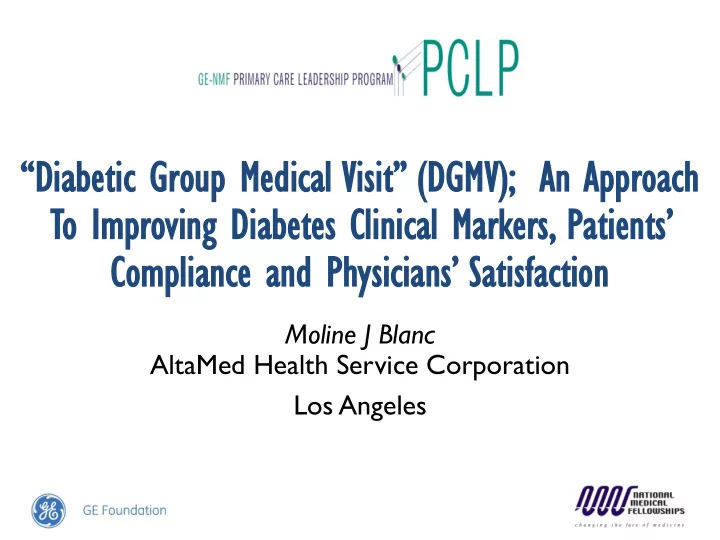

“Diabetic Group Medical Visit” (DGMV); An Approach To Improving Diabetes Clinical Markers, Patients’ Compliance and Physicians’ Satisfaction Moline J Blanc AltaMed Health Service Corporation Los Angeles
Ba Back ckground: ground: Diabetic Group Medical Visit • An innovative approach to diabetic education • Late 1990s: diabetes become an important health concerns and posed economic burden • COST….COST….COST….COST….COST • Movement to group based education • Supported by Balanced Budget Act of 1997 • Grants for special diabetes program • Health Care Finance Administration • Currently known as Centers for Medicare & Medicaid Services • Uniform reimbursement for group diabetes education • Big incentive for diabetes Educators (Patti L. Rickheim, 2002)
Introd troduction uction AltaMed Program Overview • Directed by Five providers supported by Health Education Staff • Two hours sessions about one month apart from February to April ‘14 • conducted at AltaMed clinics in Los Angeles and Orange county AltaMed Program objectives • Increase patients knowledge on diabetes • Evoke behavior changes and Improve clinical outcome • Address Cost: financially sustainable program that can be replicated across the board. AltaMed Program Outcome • 27 graduates: Average class attendance: 8 patients • Average provider productivity: 4 patients visits/hr
gy : Pilot Program Evaluation Met ethodolo hodology • Quantitative data analysis • Pre and Post Lab markers: Seven primary end point • BMI • systolic and diastolic BP • cholesterol • LDL • Glucose • Hemoglobin A1c • Goal: Use IBM SPSS to look for pre and post differences and examine significance of those difference.
gy : Pilot Program Evaluation Met ethodolo hodology • Qualitative data analysis • Patients’ survey • Assess patients general wellbeing since completing the program • Assess patients mindset about the program • Assess lifestyle changes since completing the program • Providers’ survey • Patients compliance and involvement in their care • Provider comfort level with patients ability to self manage • Patients improvement during & after the program • Style of diabetic education prefer or find most effective
Res esults: ults: Quantitative Data BMI N=24; Mean diff= .51; P=.326 Systolic BP N=20; Mean diff= 9.0; P= .049 Diastolic BP N= 19; Mean diff= 0.7; P= 0.768 Cholesterol N=10; Mean diff= 20.9; P= 0.003 LDL N= 11; Mean diff= 20.9; P= 0.001 Hemoglobin A1c N=19; Mean diff= .94; P=0. 014
Res esults: ults: Qualitative Data Patients’ survey • Patients feel better about their general health • Patients were empower and incorporate lifestyle change • Patients needs were met and increase trust in providers • Patients agree that the program had positive impact on their life and management of their disease Providers’ Survey • Patients are more prone to comply with suggestions • Patients are more active in their care • Physician level of comfort for self management remain unchanged pre and post program • preference and effectiveness of group visit varies among providers especially when compare to individual visits
Disc scussion ssion • Clinical markers and Patients’ life improve - significant decrease in Cholesterol, LDL and Hemoglobin A1c - patients’ life and disease process were positively impacted • Self management disparity : Patients agree to have better control over DM and are empowered to make life changes. Most agree to have made lifestyle changes, but Providers comfort in the ability for self management did not change: what is this disparity telling us??? • Are we good at estimating patients ability to self manage? Are we shooting for perfection and ignore the small progress that our patients are making to improve their disease and overall health. Conclusio clusions ns • Diabetes Group Medical Visits (DGMVs) have positive impact on patients overall health • DGMVs pilot program at AltaMed met its objectives
Rec ecomm ommen enda dations tions Run the program with better guidelines Inclusion/exclusion criteria should be set Established a more systematic ways to collect and documents pre and post data. Advertise the program as part of patients usual visits with their providers Define the role of group versus individual sessions Patients who view the group visit as just an educational or support group might be less motivated to attend those sessions. More patients might probably enroll in group sessions if the benefits of this visit are well explained. Cost should be directly addressed!
Ack ckno nowl wled edgements ements Thank you • Dr. Barbara Saltzman • Assistant professor: Department of Public Health and Preventive Medicine: University of Toledo College of Medicine and Life Sciences • Dr. Michael Hochman : site supervisor • Michael Eaton PA-C : clinical experience • Dr. Kevin Lohenry : local faculty advisor • Bessie Ramos : coordinator
Recommend
More recommend